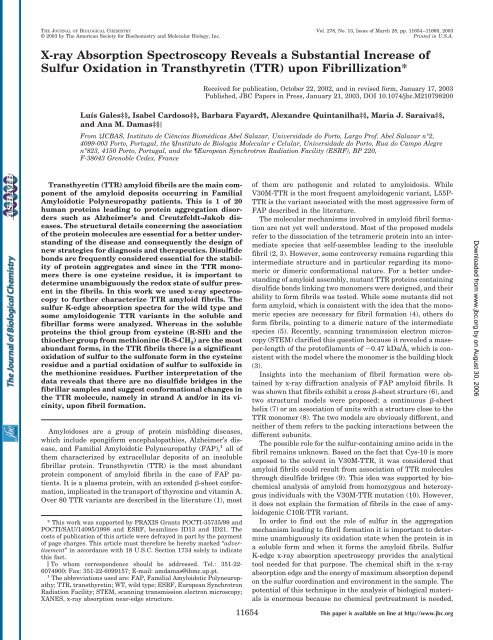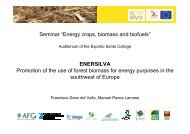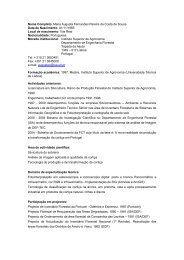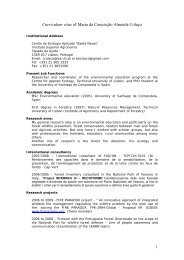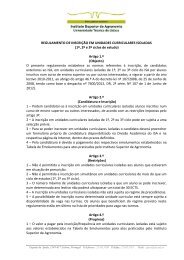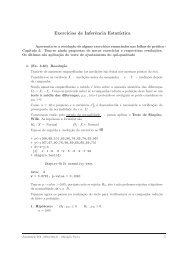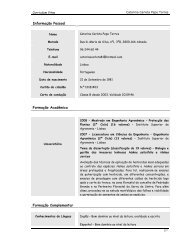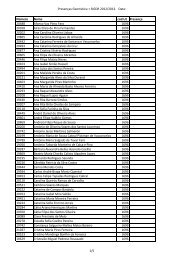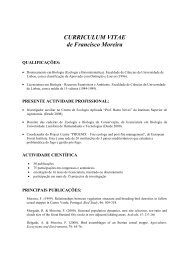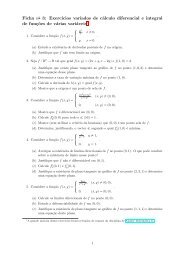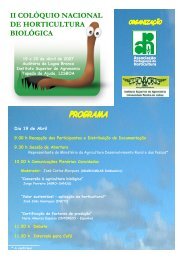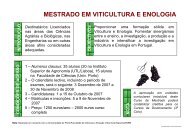X-ray Absorption Spectroscopy Reveals a Substantial Increase of ...
X-ray Absorption Spectroscopy Reveals a Substantial Increase of ...
X-ray Absorption Spectroscopy Reveals a Substantial Increase of ...
You also want an ePaper? Increase the reach of your titles
YUMPU automatically turns print PDFs into web optimized ePapers that Google loves.
11656Sulfur Oxidation in TTR upon FibrillizationTABLE ISpacing <strong>of</strong> equatorial and meridional reflectionsMeridional Equatorial Relative intensityd(obs) Åd(obs) Å12.5 s10.3 w6.56 m4.85 m4.65 s4.15 wmeasurements <strong>of</strong> spin-labeled TTR mutants suggest a distance<strong>of</strong> 8 Å between subunits interfaces in the fibrils (15) thatcould originate that reflection.The three observed meridional reflections indexed as Braggreflections, fit a repeating unit <strong>of</strong> 116.3 Å 0.1, close to the115.5 Å already proposed (7). This 4 higher period (4 29 116 Å), can be due to a twist in the -strands along the fibrilaxis, leading to the 116 Å repeat.Sulfur K-edge XANES—The K-edge spectra <strong>of</strong> cysteine, cystine,methionine, methionine sulfoxide, and anthraquinone-2-sulfonic acid are shown in Fig. 2. The energies <strong>of</strong> maximumabsorption for these compounds are 2.4730, 2.4723, 2.4731,2.4759, and 2.4809 keV, respectively. The scans were run witha step size <strong>of</strong> 0.00017 keV near the edge region, and the measuredvalues are in agreement with those found in the literature(11, 16). The shapes <strong>of</strong> the spectra are clearly different exceptfor cysteine and methionine that look very similar. Moreover,as described in previous studies (16), it can be observed that thehigher the energy <strong>of</strong> maximum absorption the greater is thepeak area.The sulfur K-edge spectra <strong>of</strong> the WT-, V30M-, L55P-, andC10S-TTR samples are shown in Fig. 3. Some conclusions ariseimmediately from the observation <strong>of</strong> the spectra. There are noS–S bonds present in the samples as neither spectra shows thecystine characteristic peak. The three energies <strong>of</strong> maximumabsorption observed are 2.473 keV, 2.476 keV, and 2.481 keVindicating the presence <strong>of</strong> cysteine and/or methionine, methioninesulfoxide, and sulfonated cysteine. Although the shapes <strong>of</strong>the spectrum <strong>of</strong> TTR variants are roughly similar, there arepronounced differences between the non-polymerized and thepolymerized forms: in the fibrillar samples there is a largeamount <strong>of</strong> oxidized sulfur (stronger peak at 2.4759 keV fromthe S-sulfoxide and stronger peak at 2.4809 keV from theS-sulfonated).Since more detailed interpretations demand a quantitativeanalysis, the experimental protein spectra were simulated bylinear combination <strong>of</strong> the spectra from the reference samples.The simulated spectra are shown in Fig. 4, and the results <strong>of</strong>the fits and corresponding relative errors are presented inTable II.TTR is a homotetramer with 127 amino acids per monomer.Cys-10 and Met-13 are the only sulfur-containing amino acidsin the wild-type protein and L55P-TTR. V30M-TTR containsone cysteine and two methionines and variant C10S-TTR containsonly one methionine.In the non-polymerized protein samples there is a higherfraction <strong>of</strong> cysteines oxidized to the sulfonated form (24–28%)then methionines oxidized to the sulfoxide form (10% or less),which is consistent with Cys-10 being more exposed to thesolvent then Met-13 as revealed by the x-<strong>ray</strong> crystallographicstructures <strong>of</strong> these variants (9, 17, 18). According to the crystalstructure <strong>of</strong> V30M-TTR variant, the extra methionine, Met-30,is buried in the molecule and not exposed to the solvent. Thereforein this case, the methionine sulfoxide probably results onlyfrom the partial oxidation <strong>of</strong> Met-13 as it will be the case for thewild type and the other variant proteins. The presence <strong>of</strong> theFIG. 2. Sulfur K-edge XANES spectra for the referencecompounds.FIG. 3.Sulfur K-edge XANES spectra <strong>of</strong> protein solutions (a)and fibril solutions (V30M-, WT-, and L55P-TTR) (b). V30M-TTRspectra are present in blue, WT-TTR in black, L55P-TTR in redand C10S-TTR in green.S-sulfonated in C10S-TTR variant is residual (2%) and mostimprobable since no cysteines are present in the protein. Thecorresponding peak, which is very small, should arise from themultiple scattering effects at the high energy end <strong>of</strong> the spectra(11).Downloaded from www.jbc.org by on August 30, 2006
Sulfur Oxidation in TTR upon Fibrillization 11657FIG. 4. Experimental and simulated sulfur K-edge XANES spectra for the TTR samples (thick lines, experimental; thin lines,simulation). Soluble WT-TTR (a), V30M-TTR (b), L55P-TTR (c), and C10S-TTR (d); and fibrillar WT-TTR (e), V30M-TTR (f), and L55P-TTR (g).The percentages <strong>of</strong> the different forms <strong>of</strong> sulfur used in the simulations are presented in Table II.SampleTABLE IIThe percentage <strong>of</strong> the different forms <strong>of</strong> sulfur used to simulate the sample spectraRelativeaerrorReduced S Sulfoxide Sulfonate Cys/Met Cys/CysS Met/MetS% % % ratio %/% %/%Soluble proteinsV30M-TTR 0.0020 86 5 9 1/2 73/27 92/8L55P-TTR 0.0024 81 5 14 1/1 72/28 90/10WT-TTR 0.0033 84 4 12 1/1 76/24 90/10C10S-TTR 0.0053 97 1 2 0/1 99/1FibrilsV30M-TTR 0.0077 51 19 31 1/2 7/93 72/28L55P-TTR 0.0065 46 16 38 1/1 24/76 68/32WT-TTR 0.0048 58 16 26 1/1 52/48 68/32a Sum <strong>of</strong> the squares <strong>of</strong> the residuals between the original and the simulations in the region from 2.470 to 2.485 keV divided by the number <strong>of</strong>experimental points measured.The data concerning the cysteine residue show that there isa slight increase in the S-sulfonated content from the wild-typeprotein (24%) to V30M-TTR (27%) to L55P-TTR (28%). In fact,it was already reported that sulfur K-edge spectroscopy detectschanges <strong>of</strong> 5% in the thiol-to-disulfide ratio (11). In our experiments,we were able to obtain a higher accuracy in thethiol-to-sulfonate ratio, 2%, because the energy peaks werenot so close to each other. However, the observed differencesare near the sensitivity <strong>of</strong> the experimental method.To further understand the accuracy <strong>of</strong> the simulated spectraand their relative errors the experimental spectrum <strong>of</strong> thesoluble L55P-TTR was compared with the spectra simulatedwith the parameters that best fit the results <strong>of</strong> the four TTRmutants in the soluble form. These spectra and correspondingerrors are presented in Fig. 5. When the L55P-TTR spectrumwas simulated with the parameters obtained for the best fit <strong>of</strong>WT-TTR (84% reduced sulfur, 4% sulfoxide, and 12% sulfonate),V30M-TTR (86% reduced sulfur, 5% sulfoxide, and 9%sulfonate) and C10S-TTR (97% reduced sulfur, 1% sulfoxide,and 2% sulfonate), the relative errors (0.0083, 0.019, and 0.059,respectively) were over three times the error associated withthe spectrum that represents the best fit for L55P-TTR, whichis 0.0024.The results suggest that L55P-TTR, the most aggressivevariant described in the literature until now, is the variantwith the higher content <strong>of</strong> sulfonated sulfur (28%).Analysis <strong>of</strong> the fibrillar material reveals that the percentage<strong>of</strong> sulfur from the methionine residues that are in the sulfoxideform (V30M-TTR: 28%, L55P-TTR and WT-TTR: 32%) are approximately3–4 higher then the corresponding value in thesoluble proteins (V30M-TTR: 8%, L55P-TTR and WT-TTR:10%). The cysteines are even more oxidized: in V30M-TTRvariant 93% are in the sulfonated form, in L55P-TTR 76% andin WT-TTR protein 48% <strong>of</strong> the cysteines are oxidized. It isworth mentioning that L55P-TTR variant was not polymerizedby acidification. This indicates that cysteine and methionineoxidation is not an artifact resulting from partial denaturationdue to acidification but results from structural alterations duringor upon polymerization.Thi<strong>of</strong>lavine-T Binding Assay—In order to improve our understandingabout the role <strong>of</strong> sulfur oxidation in the self-assembly<strong>of</strong> TTR protein, the susceptibility to amyloid formation<strong>of</strong> reduced WT-TTR was monitored using the thi<strong>of</strong>lavine-Tbinding assay.A soluble WT-TTR sample (100 g) was reduced with dithiothreitol(10 mM), and the procedure to amyloid fibril formationby acidification was followed. The reducing agent was removedfrom the fiber solution just before the thi<strong>of</strong>lavine-T bindingassay in order to avoid possible quenching <strong>of</strong> the spectra. Theresults show that the reduced protein solution had strong susceptibilityto fibril formation (Fig. 6).Downloaded from www.jbc.org by on August 30, 2006
11658Sulfur Oxidation in TTR upon FibrillizationFIG. 5. Sulfur K-edge XANES spectrum <strong>of</strong> soluble L55P-TTRand the spectra generated by linear combination <strong>of</strong> the referencesulfur forms spectra. The experimental and best fit <strong>of</strong> thesimulated spectra are presented in red (thick and thin lines, respectively).The black, blue, and green spectra are simulations using the percentages<strong>of</strong> oxidation form <strong>of</strong> sulfur found in the WT-, V30M-, andC10S-TTR soluble samples.FIG. 6.Thi<strong>of</strong>lavine-T binding assay for WT-TTR and reducedWT-TTR amyloid fibrils formed by acidification.DISCUSSIONAlthough many aspects <strong>of</strong> amyloid diseases are known, amolecular model describing the interactions between amyloidogenicunits at high resolution, e.g. revealing the contactsbetween different atoms that are responsible for a highly stablestructure, as it is the case <strong>of</strong> the amyloid fibrils, does not exist.This is a priority for defining how to design a drug that either(i) directly binds to a contact region and destroys the interactionor (ii) rather occupies the binding site <strong>of</strong> one amyloidogenicFIG. 7.The L55P-TTR monomer (PDB ID: 5TTR) showing thelocal electrostatic environment around Cys-10 and Met-13. Insalmon, the Gly-53–Gly-57 main chain conformation and side chain <strong>of</strong>His-56 <strong>of</strong> WT-TTR. The figure was produced with SETOR (33).unit, avoiding its contact with a nearby unit inhibiting amyloidformation.In this work we conclude that in TTR amyloid fibrils, Cys-10,the only cysteine residue present in the TTR protein, does notform disulfide bridges with other molecules and that sulfurcontainingamino acids, namely Cys-10 and Met-13, are significantlyoxidized upon polymerization. The oxidation <strong>of</strong> theseamino acids may occur before fiber formation or in the maturefiber. In fact, there are two possibilities: oxidation <strong>of</strong> bothamino acids leads to a more polar region capable <strong>of</strong> forminghydrogen bonds with other molecules and this leads to amyloidfibers; or aggregation leads to conformational changes in theprotein that expose Cys-10 and Met-13 to the solvent allowingtheir subsequent oxidation. However, oxidation <strong>of</strong> both aminoacids is not required for fibril formation as revealed by thestrong susceptibly <strong>of</strong> reduced protein samples to form amyloid.Sulfur oxidation might result as a consequence <strong>of</strong> structuralalterations during protein aggregation exposing the cysteinesand methionines to the solvent.Although cysteine-free TTR mutants are capable <strong>of</strong> amyloidfibril formation (19), showing that disulfide linkages are notrequired for fibrillogenisis, there are a number <strong>of</strong> studies relatingthe amyloidogenic behavior <strong>of</strong> TTR with the oxidationstate <strong>of</strong> sulfur from their cysteine residues. This relation is notclear yet, since some results point to an increased amyloidogenicity<strong>of</strong> sulfonated transthyretin (20), while others indicatethat the stability <strong>of</strong> the tetramer is increased by binding <strong>of</strong>sulfite to Cys-10 (21). Nevertheless, S-sulfonated transthyretinhas been detected in serum and it was reported that it issignificantly more abundant in diseased individuals (22, 23).The data show that a significant fraction <strong>of</strong> the thiol group <strong>of</strong>cysteines present in the soluble TTR samples is in the sulfonateform. A quantitative study <strong>of</strong> the sulfinic and sulfonic acidcontent was carried out in different proteins leading to theconclusion that a significant number <strong>of</strong> cysteines is irreversiblyoxidized. In fact, one in four cysteines was estimated as beingreactive to oxidants (24).Examination <strong>of</strong> the protein models available in the ProteinData Bank (25) shows that only 2.5% <strong>of</strong> the structures containDownloaded from www.jbc.org by on August 30, 2006
Sulfur Oxidation in TTR upon Fibrillization 11659oxidized cysteines. However, in a significant amount <strong>of</strong> theprotein structures the cysteines are buried and not exposed tothe solvent. Furthermore, in some models the cysteic acid wasrepresented by three water molecules around the sulfur, andtherefore its oxidation state is not immediately obvious. In thex-<strong>ray</strong> crystallographic structures <strong>of</strong> TTR proteins, the oxidation<strong>of</strong> Cys-10 has not been detected. This might be explained by thefact that in those structures the N-terminal is disordered andCys-10 is in most cases the first residue to be observed. In factlarge temperature factors were assigned to the sulfur atom <strong>of</strong>that residue. In human serum, sulfated TTR as well as cysteinylatedTTR were detected using mass spectroscopy (22).Further insight to the structure <strong>of</strong> amyloid fibrils can beobtained from the crystallographic structure <strong>of</strong> the TTR variantsand the results here reported. Met-13 is not buried in themolecule but still partially protected by Lys-15, Glu-54, His-56,Arg-104, and Thr-106. Cys-10 is at the external surface <strong>of</strong> themolecule and also somehow protected, although not as much asMet-13. It is flanked by the main chain <strong>of</strong> Leu-12 and Met-13,the side chain <strong>of</strong> Arg-104, and by the main chain betweenHis-56 and Thr-60 as shown in Fig. 7. The crystal structure <strong>of</strong>G53S/E54D/L55S-TTR, a constructed variant that polymerizesspontaneously at physiological conditions, revealed astructural change <strong>of</strong> the edge strand D exposing Met-13 (26).Also in the highly amyloidogenic L55P-TTR variant, a movement<strong>of</strong> strand D leading to a long loop between strands Cand E was observed (18). This loop contains the His-56–Thr-60 region that mediates the access <strong>of</strong> the solvent toCys-10 and to Met-13. The effect <strong>of</strong> the His-56–Thr-60 regionover the accessibility <strong>of</strong> Met-13 to the solvent was determinedfor the x-<strong>ray</strong> crystallographic structures <strong>of</strong> WT- (PDB ID:1F41) and L55P-TTR (PDB ID: 5TTR), using Turbo-Frodo(27). The accessible surface <strong>of</strong> Met-13 in the WT-TTR is 26 Å 2 ,half <strong>of</strong> the accessible surface <strong>of</strong> Met-13 in the L55P-TTR,which is 52 Å 2 . The reported values are the averaged resultsfor the accessible surfaces <strong>of</strong> all Met-13 in the crystallographicasymmetric unit. The accessible surface <strong>of</strong> Cys-10was not calculated since the N-terminal in these TTR crystalstructures is disordered.Since in the fibrils we observe a substantial increase in thenumber <strong>of</strong> Cys-10 and Met-13 amino acids in the oxidized form,we propose that this occurs due to a movement <strong>of</strong> the proteinmain chain in the edge region His-56–Thr-60, as it happens inthe case <strong>of</strong> L55P-TTR. In 2-microglobulin, another -sandwichprotein, it was reported that a restructuring <strong>of</strong> a bulgethat separates two short strands leads to a protein with alonger strand located at the edge <strong>of</strong> the molecule and increasedamyloidogenic properties (28, 29). Besides this rearrangement<strong>of</strong> the edge strand, the authors reported a rotation <strong>of</strong> His-51increasing the hydrogen bonding potential <strong>of</strong> that strand andtherefore allowing the formation <strong>of</strong> intermolecular interactions.In the case <strong>of</strong> TTR, also His-56, located at the edge-strand that we believe is modified for fibril assembly, has adifferent conformation in WT- and L55P-TTR (Fig. 7). Furthermore,a contact between this amino acid and a glutamic acid <strong>of</strong>a nearby molecule was reported as an abnormal interactionthat might be important for amyloid formation (18).Recently hydrogen/deuterium exchange combined with NMRanalysis was used to identify the stable core <strong>of</strong> 2-microglobulinamyloid fibrils and suggests a loss <strong>of</strong> structure at the edge<strong>of</strong> the native -sheet during self-assembly <strong>of</strong> the protein (30). Ina different study, it was revealed that six <strong>of</strong> the seven strandspresent in this -sandwich protein are protected from H/Dexchange in the fiber structure (31).According to the CATH-Protein Structure Classification (32),TTR and 2-microglobulin belong to the main -class <strong>of</strong> proteins,both have a sandwich architecture and an immunoglobulin-liketopology. Therefore, a high level <strong>of</strong> structure similarityexists between the two proteins, and it is most probablethat, as in the case <strong>of</strong> TTR, the two -sheet cores are maintainedin the fibrils. An assembly mechanism, where two edgestrands are moved away and the penultimate strands A and Bare exposed was recently proposed for TTR (15). This wouldcertainly explain oxidation <strong>of</strong> cysteine (near strand A) andmethionine (on strand A).The x-<strong>ray</strong> diffraction patterns <strong>of</strong> TTR amyloid fibrils revealedthe classic -structure with the hydrogen bonds withinthe -sheets parallel to the fiber axis. The presence <strong>of</strong> a broadreflection at 10 Å indicates that the fiber is composed <strong>of</strong> two sheets (14) as previously proposed. Along the fiber axis, the 29Å repeating unit may correspond to a monomeric species, althoughonly the 6th and higher order reflections are detected.The lower order reflections were not seen and are not usuallydetected (7, 8), which may indicate that the fundamental spacing<strong>of</strong> 29 Å includes an ordered region with the -chains perpendicularto the fibril axis, the core <strong>of</strong> the native protein, anda disordered domain (8) that may be due to the structuralalterations in the edge strands.We conclude that in TTR amyloid fibrils the repeating unitsare composed <strong>of</strong> two -sheets, resembling the TTR monomer,and that a structural alteration <strong>of</strong> the protein D-strand and theDE-loop lead to a disordered region that exposes Cys-10 andMet-13 to the solvent. We believe that the newly exposed surfaceis responsible for promoting protein aggregation. Furthermore,Cys-10 does not form disulfide bridges, and thereforesuch bridges are not responsible for the highly packed structurepresent in the fibrils. The thi<strong>of</strong>lavine-T binding assaysalso show that the reduced protein is susceptible to amyloidformation by acidification. Therefore oxidation, at the nativeprotein state, does not seem to promote amyloid fibril formation.Future studies involve the use <strong>of</strong> compounds that specificallybind the sulfur-containing amino acids in order to testtheir role in protein aggregation.Acknowledgment—We thank P. Moreira for excellent technicalassistance.REFERENCES1. Saraiva, M. J. M. (2001) Human Mut. 17, 493–5032. McCutchen, S. L., Lai, Z. H., Miroy, G. J., Kelly, J. W., and Colon, W. (1995)Biochemistry 34, 13527–135363. Cardoso, I., Goldsbury, C. S., Muller, S. A., Olivieri, V., Wirtz, S., Damas,A. M., Aebi, U., and Saraiva, M. J. (2002) J. Mol. Biol. 317, 683–6954. Redondo, C., Damas, A. M., and Saraiva, M. J. M. (2000) Biochem. J. 348,167–1725. Serag, A. A., Altenbach, C., Gingery, M., Hubbel, W. L., and Yates, T. Q. (2001)Biochemistry 40, 9089–90966. Damas, A., Sebastião, M. P., Domingues, F. S., Costa, P. P., and Saraiva, M. J.(1995) Amyloid Int. J. Exp. Clin. Invest. 2, 173–1787. Blake, C., and Serpell, L. (1996) Structure 4, 989–9988. Inouye, H., Domingues, F. S., Damas, A. M., Saraiva, M. J., Lundgren, E.,Sandgren, O., and Kirschner, D. (1998) Amyloid Int. J. Exp. Clin. Invest. 5,163–1749. Terry, C., Damas, A. M., Oliveira, P., Saraiva, M. J., Alves, I., Costa, P.,Sakaki, Y., and Blake, C. (1993) EMBO J. 12, 735–74110. Thylen, C., Wahlqvist, J., Haettner, E., Sandgren, O., Holmgren, G., andLungren, E. (1993) EMBO J. 12, 743–74811. Rompel, A., Cinco, RM., Latimer, M. J., McDermott, A. E., Guiles, R. D.,Quintanilha, A., Krauss, R. M., Sauer, K., Yachandra, V. K., and Klein, M.(1998) Proc. Natl. Acad. Sci. U. S. A. 95, 6122–612712. Bellacchio, E., McFarlane, K. L., Rompel, A., Robblee, J. H., Cinco, R. M., andYachandra, V. K. (2001) J. Synchrotron Rad. 8, 1056–105813. Hammersley, A. P. (1998) ESRF Internal Report, ESRF98HA01T, FIT2DV9.129 Reference Manual V3.114. Perutz, M. F., Finch, J. T., Berriman, J., and Lesk, A. (2002) Proc. Natl. Acad.Sci. U. S. A. 99, 5591–559515. Serag, A. A., Altenbach, C., Gingery, M., Hubbel, W. L., and Yates, T. Q. (2002)Nat. Struct. Biol. 9, 734–73916. Sarret, G., Connan, J., Kasrai, M., Eybert-Bérard, L., and Bancr<strong>of</strong>t, G. M.(1999) J. Synchrotron Rad. 6, 670–67217. Blake, C. C., Geisow, M. J., Oatley, S. J., Rerat, B., and Rerat, C. (1978) J. Mol.Biol. 121, 339–35618. Sebastião, M. P., Saraiva, M. J. M., and Damas, A. M. (1998) J. Biol. Chem.273, 24715–24722Downloaded from www.jbc.org by on August 30, 2006


